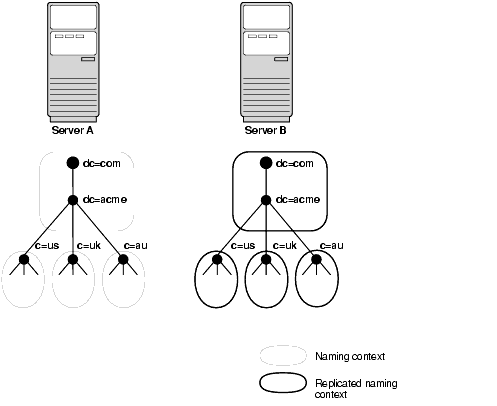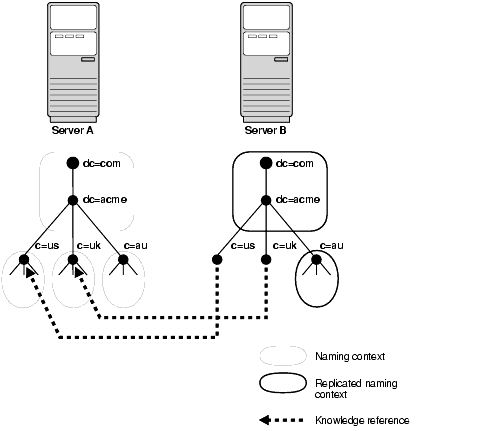10g (9.0.4)
Part Number B12118-01
Home |
Solution Area |
Contents |
Index |
| Oracle® Internet Directory Administrator's Guide 10g (9.0.4) Part Number B12118-01 |
|
Directory Concepts and Architecture, 10 of 15
Although an online directory is logically centralized, it can be physically distributed onto several servers. This distribution reduces the work a single server would otherwise have to do, and enables the directory to accommodate a larger number of entries.
A distributed directory can be either replicated or partitioned. When information is replicated, the same naming contexts are stored by more than one server. When information is partitioned, one or more unique, non-overlapping naming contexts are stored on each directory server. In a distributed directory, some information may be partitioned and some may be replicated.
This section contains these topics:
Replication is the process of copying and maintaining the same naming contexts on multiple directory servers. It improves performance by providing more servers to handle queries, and reliability by eliminating risks associated with a single point of failure.
Replication can be either full or partial.
Full replication involves propagating the entire DIT to another node.
Partial replication involves propagating one or more subtrees, rather than the entire DIT, to another node.
The directory servers that participate in the replication of a given naming context form what is called a directory replication group (DRG). The relationship among the directory servers in a DRG is represented on each node by a special directory entry called a replication agreement.
Each copy of a naming context contained within a server is called a replica. Replicas can be read-only, updatable, or both. Servers that hold updatable replicas are called suppliers. Their changes are propagated to other servers called consumers.
A directory replication group can be either single-master, multimaster, or fan-out.
A single-master replication group has only one supplier replicating changes to one or more consumers. Only the supplier can be updated, and consumers are read-only.
Multimaster replication, also called peer-to-peer or n-way replication, enables multiple sites, acting as equals, to manage groups of replicated data. In a multimaster replication environment, each node is both a supplier and a consumer node, and the entire directory is replicated on each node.
A fan-out replication group, also called a point-to-point replication group, has a supplier replicating directly to a consumer. That consumer can then replicate to one or more other consumers. The replication can be either full or partial.
In a directory replication group, the protocol for transferring data between nodes can be based on either Oracle9i Advanced Replication or LDAP.
Figure 2-6 shows a replicated directory.

|
See Also:
Chapter 24, "Directory Replication Concepts" for a more detailed discussion of replication, including: Oracle9i Advanced Replication architecture, LDAP-based replication, change log purging, conflict resolution, and the replication process |
Partitioning, in which each directory server stores one or more unique, non-overlapping naming contexts, is another way of distributing directory information.
Figure 2-7 shows a partitioned directory in which some naming contexts reside on different servers.

In Figure 2-7, four naming contexts reside on Server A:
Two naming contexts on Server A are replicated on Server B:
The directory uses one or more knowledge reference to locate information that is requested of Server B, but that resides on Server A. It passes this information to a client in the form of a referral.
|
|
 Copyright © 1999, 2003 Oracle Corporation. All Rights Reserved. |
|